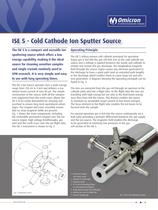
Catalog excerpts

MBE PRO 753-V01/Oct10 ISE 5 - Cold Cathode Ion Sputter Source The ISE 5 is a compact and versatile ion sputtering source which offers a low energy capability, making it the ideal source for cleaning sensitive samples and single crystals routinely used in SPM research. It is very simple and easy to use with long operating times. The ISE 5 Ion Source operates over a wide energy range from 250 eV to 5 keV and delivers a maximum beam current of over 80 µA. The simple construction of the source, with all the components supported from the earth cover, allows the ISE 5 to be easily dismantled for cleaning and overhaul to ensure long term operational advantages. The magnet and cover assembly ensure that no stray magnetic fields are present. Fig. 1 shows the main components, including the removable permanent magnet over the ion source region, high voltage feedthroughs, gas inlet and the earth cover over the ion flight tube. The ISE 5 instrument is shown in Fig. 2. Operating Principle The ISE 5 utilises proven cold cathode principals for operation. Argon gas is fed into the gas cell that acts as the cold cathode ion source and a voltage is applied between the anode and cathode to initiate and sustain the gas discharge. The longitudinal magnetic field through the source region causes any electrons generated in the discharge to have a spiral path (and an extended path length) in the discharge which enables them to cause large ion and electron generation. A diagram showing the operating principals can be found in Fig. 3. The ions are extracted from the gas cell through an aperture in the cathode plate and into a flight tube. In the flight tube the ions are travelling with high energy but are only at the final beam energy once they have left the source. This feature enables the source to maintain an acceptable target current at low beam energies. The focus element in the flight tube enables the ion beam to be focused onto the sample. For normal operation gas is fed into the source continuously via a leak valve providing a pressure differential between the gas supply and the ion source. The magnetic field enables the discharge to be generated at relatively low pressures in the gas cell section of the ISE 5. 2 1 3 4 5 1 Permanent magnet over source region 2 Cathode HV feedthrough 6 3 Connector shield 4 CF 70 mm OD mounting flange 7 (6 x M6 clearance bolt holes) 5 Anode (Beam Energy) HV feedthrough Fig. 1: Schematic of ISE 5 6 Earthed cover over ion flight tube 7 Focus HV feedthrough www.omicron.de Fig. 2: ISE 5 cold cathode ion source.
Open the catalog to page 1
Technical Information: Ion source: > 80 µA at 5 keV > 25 µA at 0.5 keV Spot size: 10 mm at 5 keV (200 mm working distance) 15 mm at 1 keV Focus 0.3 keV to 5 keV Beam current: (Beam energy) Cold cathode ionization chamber Energy range: Anode (200 mm working distance) Magnetic field Operating pressure: x 10 -6 mbar to 5 8 x 10 -5 mbar Cathode Gas cell Flight tube Earth cover (at cathode potential) (at earth potential) Fig. 3: Diagram of ion source showing principle of operation. (using a pumping speed of 200 l/s) Operating gas: Sample Gas inlet Argon, Nitron and other inert gases Recommended...
Open the catalog to page 2All Scienta Omicron catalogs and technical brochures
-
NanoESCA
4 Pages
-
UHV Suitcase
2 Pages
-
ARPES-Lab
4 Pages
-
Cryo Manipulators
2 Pages
-
XPS-Lab
2 Pages
-
Fermi DryCool SPM
8 Pages
-
TESLA JT SPM
8 Pages
-
EFM Evaporators
8 Pages
-
Argus CU
7 Pages
-
UHV NANOPROBE
12 Pages
-
Fermi SPM
8 Pages
-
Leonova Diamond
8 Pages
-
Leonova Emerald
12 Pages
-
Intellinova
4 Pages
-
MULTIPROBE
8 Pages
-
Omicron EFM V05
8 Pages
-
PRO-75/100 MBE Systems
2 Pages
-
EVO-25/50 MBE Systems
2 Pages
-
LAB-10 MBE System
2 Pages
-
EKF 300
2 Pages
-
Omicron CN 10 V02
2 Pages
-
MBD-LEED
8 Pages
-
FOCUS PEEM
16 Pages
-
Argus
12 Pages
-
MULTISCAN Lab
2 Pages
-
LT NANOPROBE
8 Pages
-
UHV STM 1
2 Pages
-
Cryogenic STM & SFM
4 Pages
-
SPHERA
8 Pages
-
NanoSAM Lab
6 Pages
Archived catalogs
-
VT SPM
11 Pages
-
LT STM_2017
16 Pages
-
ESCA+_2010
8 Pages
-
VT SPM_2012
20 Pages
-
LT STM_2012
16 Pages
-
SPM PROBE
2 Pages
-
MATRIX SPM Control System
8 Pages
-
MS5 & Control Unit
2 Pages
-
EFM 2
8 Pages
-
EKF 1000
2 Pages
-
SPECTALEED
8 Pages
-
CMA 100
4 Pages
-
NanoESCA
8 Pages
-
Multiscan STM
2 Pages
















































